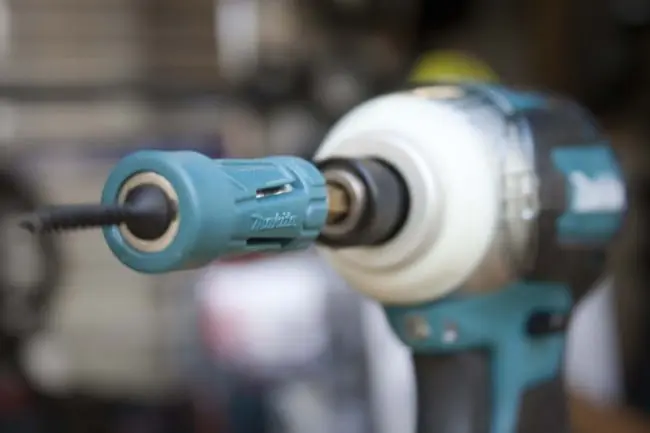The Makita Impact GOLD bits include bit holders, nut setters, socket adapters, and more. We even checked out their handy case. Unlike many competing products, it gives you easy access to the bits without having to literally rip them out of the housing. The 21-piece kit includes a magnetic two-piece holder.
Makita Impact GOLD Ultra Design

The design works simply. You insert the bit holder into your impact driver and remove the plastic sleeve which houses a neodymium magnet. After this, insert the bit and then replace the sleeve. You can now insert a screw, and the plastic magnetic-tipped holder gives you one-handed use of your driver to sink screws. And, the bit holder is tough—it takes a real man to remove the inserted bits. This is because it uses a non-magnetic snap-ring instead of a magnet—eliminating metal debris build-up common in magnetic holders. It also has the added benefit of getting rid of any slop in the insert bit. This results in less cam-out due to wobble.
The Makita Impact GOLD bits work particularly well with high-torque impact drivers. You can tell that the steel tips are really precisely engineered. They have a precise fit into our reference Grip-Rite test screws. The solid fit made them less prone to cam-out. They also drove a considerable amount of screws compared to several other comparable impact-rated bits we tested.
Similar to some other technologies we’ve seen, both Makita’s Impact GOLD bit holder and the bits themselves feature something called “Xtreme Torsion Technology”. Basically, the torsion section (shaft) of the bit flexes under load. This takes the pressure off of the tip of the bit. It lets you pull off high torque applications without snapping bits as quickly. This is particularly useful in metal self-tapping applications through steel sheet metal.
Makita Impact GOLD Ultra Magnetic Insert Bit Set Testing
We use a ton of #2 bits. In addition to having tested #2 bits in the past when we reviewed impact driver bits, I simply had plenty of them on hand. While we tested 2-inch #2 Phillips bits in the past, using Makita’s insert bits didn’t seem like we were varying much in our application, except that we used Makita’s bit holder.
The advantage here, of course, is that the Ultra Magnetic Bit Holder uses a neodymium magnet. This holds the screw securely when driven. Did this offer an unfair advantage? Perhaps, but Makita sells this system, so it didn’t strike us as unfair to use it in the manner for which it was designed. We also would have had to have gone out of our way to use another brand’s bit holder.
Driving Drywall Screws
The 18V impact driver we used for testing was set to the highest impact/speed setting. We chose the 1-5/8″ Grip-Rite drywall screw because it’s a popular fastener and easily available at places like Home Depot.
The testing material was a 3/4” piece of red oak. We placed this atop two sandwiched pieces of 3/4” plywood subfloor. We like using the red oak as the top layer. It presents a somewhat more difficult load for the bits. It also more accurately simulates a higher stress and torque setting for the bit to repeatedly power through.
I did all drilling one-handed to allow the tool to do the work and to avoid skewing the results. Bit failure was determined when the bit was not longer able to grip into the head of the screw securely. At this point I experienced significant cam-out and/or the bit failed. I retired each bit after four of five sequential cam-outs. Several runs were performed until I was sufficiently convinced my results were consistent.
Makita Impact GOLD Ultra Magnetic Insert Bit Set Results
As far as impact-ready bits go, the Makita bits did really well, resisting cam-out better than most other bits I tested. The head simply fits our screws really well. Makita pulled off nearly 200 screws, bettering all but three of the other brands we tested previously. In terms of cost-per-screw, however, Makita was one of the lowest, making it one of the better deals on the market for an impact-ready bit.








